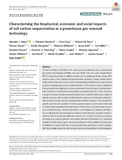JavaScript is disabled for your browser. Some features of this site may not work without it.
| dc.contributor.author | Sykes, Alasdair J. | |
| dc.contributor.author | Macleod, Michael | |
| dc.contributor.author | Eory, Vera | |
| dc.contributor.author | Rees, Robert M. | |
| dc.contributor.author | Payen, Florian | |
| dc.contributor.author | Myrgiotis, Vasilis | |
| dc.contributor.author | Williams, Mathew | |
| dc.contributor.author | Sohi, Saran | |
| dc.contributor.author | Hillier, Jon | |
| dc.contributor.author | Moran, Dominic | |
| dc.contributor.author | Manning, David A. C. | |
| dc.contributor.author | Goglio, Pietro | |
| dc.contributor.author | Seghetta, Michele | |
| dc.contributor.author | Williams, Adrian | |
| dc.contributor.author | Harris, Jim A. | |
| dc.contributor.author | Dondini, Marta | |
| dc.contributor.author | Walton, Jack | |
| dc.contributor.author | House, Joanna | |
| dc.contributor.author | Smith, Pete | |
| dc.date.accessioned | 2019-11-08T10:53:00Z | |
| dc.date.available | 2019-11-08T10:53:00Z | |
| dc.date.issued | 2019-09-18 | |
| dc.identifier.citation | Sykes AJ, Macleod M, Eory V, et al., (2019) Characterising the biophysical, economic and social impacts of soil carbon sequestration as a greenhouse gas removal technology. Global Change Biology, Volume 26, Issue 3, March 2020, pp. 1085-1108 | en_UK |
| dc.identifier.issn | 1354-1013 | |
| dc.identifier.uri | https://doi.org/10.1111/gcb.14844 | |
| dc.identifier.uri | http://dspace.lib.cranfield.ac.uk/handle/1826/14696 | |
| dc.description.abstract | To limit warming to well below 2°C, most scenario projections rely on greenhouse gas removal technologies (GGRTs); one such GGRT uses soil carbon sequestration (SCS) in agricultural land. In addition to their role in mitigating climate change, SCS practices play a role in delivering agroecosystem resilience, climate change adaptability, and food security. Environmental heterogeneity and differences in agricultural practices challenge the practical implementation of SCS, and our analysis addresses the associated knowledge gap. Previous assessments have focused on global potentials, but there is a need among policy makers to operationalise SCS. Here, we assess a range of practices already proposed to deliver SCS, and distil these into a subset of specific measures. We provide a multi‐disciplinary summary of the barriers and potential incentives toward practical implementation of these measures. First, we identify specific practices with potential for both a positive impact on SCS at farm level, and an uptake rate compatible with global impact. These focus on: a. optimising crop primary productivity (e.g. nutrient optimisation, pH management, irrigation) b. reducing soil disturbance and managing soil physical properties (e.g. improved rotations, minimum till) c. minimising deliberate removal of C or lateral transport via erosion processes (e.g. support measures, bare fallow reduction) d. addition of C produced outside the system (e.g. organic manure amendments, biochar addition) e. provision of additional C inputs within the cropping system (e.g. agroforestry, cover cropping) We then consider economic and non‐cost barriers and incentives for land managers implementing these measures, along with the potential externalised impacts of implementation. This offers a framework and reference point for holistic assessment of the impacts of SCS. Finally, we summarise and discuss the ability of extant scientific approaches to quantify the technical potential and externalities of SCS measures, and the barriers and incentives to their implementation in global agricultural systems. | en_UK |
| dc.language.iso | en | en_UK |
| dc.publisher | Wiley | en_UK |
| dc.rights | Attribution 4.0 International | * |
| dc.rights.uri | http://creativecommons.org/licenses/by/4.0/ | * |
| dc.subject | Soil organic carbon | en_UK |
| dc.subject | sequestration | en_UK |
| dc.subject | greenhouse gas removal | en_UK |
| dc.subject | negative emissions | en_UK |
| dc.subject | four per mille | en_UK |
| dc.subject | agriculture | en_UK |
| dc.title | Characterising the biophysical, economic and social impacts of soil carbon sequestration as a greenhouse gas removal technology | en_UK |
| dc.type | Article | en_UK |
| dc.identifier.cris | 24249489 |
Files in this item
The following license files are associated with this item:
This item appears in the following Collection(s)
-
Staff publications (SWEE) [2825]

